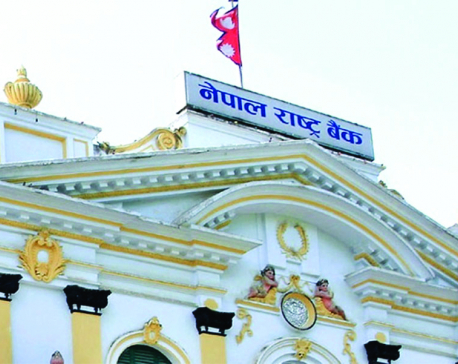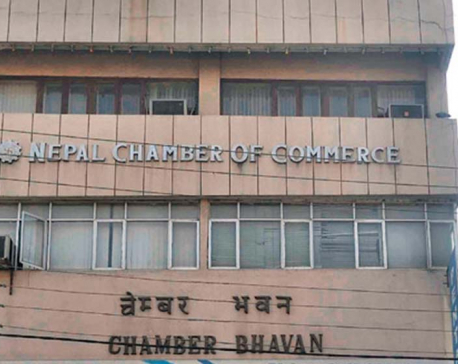
OR
NRB likely to unveil revised monetary policy today
Published On: February 10, 2023 08:30 AM NPT By: RAJESH KHANAL

The central bank is under pressure to address multiple issues including liquidity crisis, slump in real sector business, high inflation and external sector stability
KATHMANDU, Feb 10: Under pressure to address a number of factors to improve the macroeconomic indicators, the Nepal Rastra Bank (NRB) is revising the monetary policy for 2022/23.
According to an NRB source, the central bank is most probably unveiling the revised monetary policy on Friday.
The economy has hardly been better off from the depleting external economic indicators due to the contractionary monetary policy enforced since the beginning of the current fiscal year. Over the period, the balance of payments has recorded a surplus due to the check in trade deficit and increased remittance inflow.
However, the control of soaring consumer prices, reduction of exorbitant interest rates and lifting both the financial and real sectors from their degrading performance are among the major challenges facing the country’s apex monetary authority at present. “The NRB now needs to focus on improving financial mobility at the grassroot level to save the economy from a possible crisis,” said Shekhar Golchha, president of the Federation of Nepalese Chambers of Commerce and Industry.
Citing the need to check unproductive lending amid soaring imports, the central bank had implemented a contractionary monetary policy for the current fiscal year. As a measure to tighten the money supply, the NRB increased the cash reserve ratio (CRR) from 3 to 4 percent while it also increased the statutory liquidity ratio (SLR) by two percent. The SLR policy alone has been blamed for freezing Rs 102 billion of banks.
The private sector has been blaming the NRB’s tightened monetary policy for the liquidity crisis and excessive hike in interest rates by the banks, which is as high as 18 percent on loans. They blame the defective policies implemented by the NRB for the deepening liquidity crisis in the country’s banking system.
Meanwhile, the average base interest rate of banks has hit 10.68 percent. On the other hand, banks have been witnessing a notable rise in their non-performing loans due to increasing cases of defaulting of loans.
Golchha said the NRB now has to look for easing liquidity. “Unless the liquidity situation is eased, the interest rate will not fall and there will not be any improvement in entrepreneurship,” he said.
According to Golchha, a large section of the economy is now in a slump. The construction sector has shrunk by around 50-60 percent. “All of these have taken down heavily the government’s revenue collection and have also increased the budget deficit.”
International organizations have projected Nepal’s economic growth rate to stand at around five percent, while alarming that the country will have to sustain the heat of a downturn in the world economy. The inflation rate hovered around eight percent in the first six months of the current fiscal year, which the central bank itself has projected to cross 10 percent in the next few months.
Along with addressing the liquidity crisis and increasing problems seen in the financial sector, the NRB is also facing pressures to take a flexible policy in loans against shares, realty business and credits for small and medium enterprises.
Economist Keshab Acharya said Nepal will continue to see high inflation in the future due to a surge in global fuel prices and supply constraints. According to him, a recession is unlikely anytime soon. “However, the authorities concerned should take cautions to prevent these problems by implementing appropriate policies,” he said.
You May Like This

Central bank to facilitate digital payments
KATHMANDU, July 23: The Nepal Rastra Bank (NRB) will offer additional facilitation in digital payments in a bid to stop... Read More...

Former NRB governors urge central bank to take caution while devising Monetary Policy 2023/24
KATHMANDU, June 16: Former governors of Nepal Rastra Bank (NRB) have urged the central bank to enforce prudent measures through... Read More...

NRB quarterly review on monetary policy unlikely to keep fiscal stability: NCC
KATHMANDU, Nov 29: The Nepal Chamber of Commerce(NCC) has noted that the recent arrangement made by the Nepal Rastra Bank... Read More...







Just In
- Govt aims to surpass Rs 10 trillion GDP mark in next five years
- Govt appoints 77 Liaison Officers for mountain climbing management for spring season
- EC decides to permit public vehicles to operate freely on day of by-election
- Fugitive arrested after 26 years
- Indian Potash Ltd secures contract to bring 30,000 tons of urea within 107 days
- CAN adds four players to squad for T20 series against West Indies 'A'
- ‘Precast' technology introduced in the construction of bridges along Muglin-Pokhara road
- Leopard attack injures young man in Kanchanpur












Leave A Comment